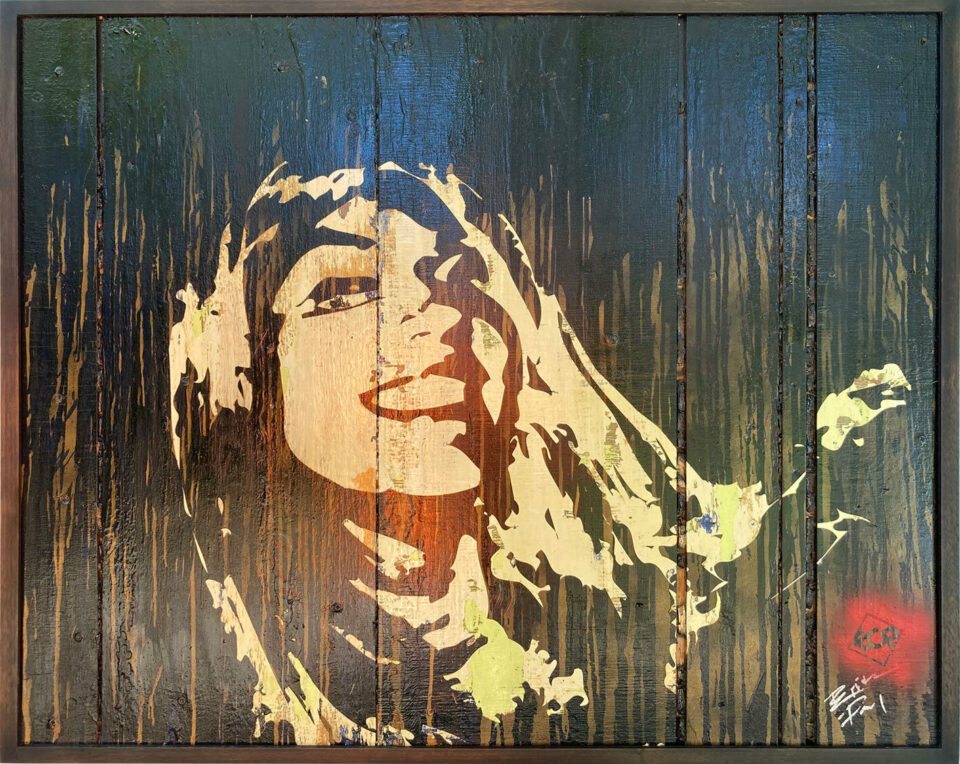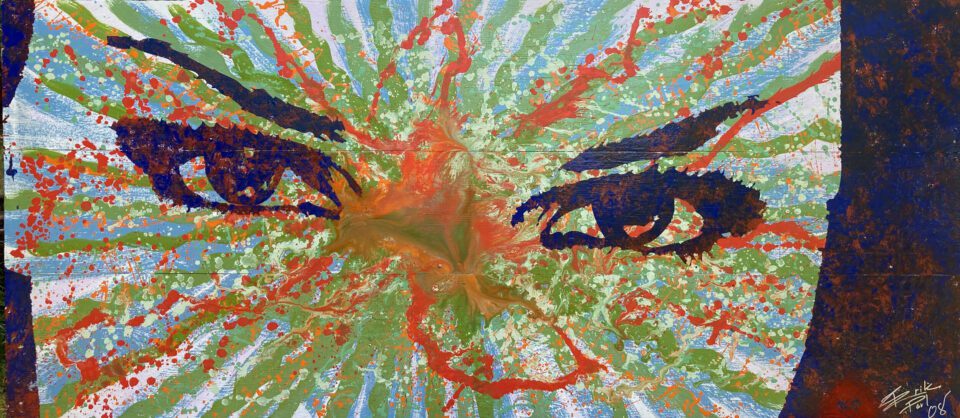Erik Paul is a California-based sign maker, graphic designer, painter, sculptor and engineer; the combined technical and creative aspects of printmaking are a particular passion. This multifaceted approach has fuelled a varied, joyful career in which the experience in one medium has helped to inform another.
A: What is it about printmaking that helps you to express the essence of your subjects?
EP: It’s the physical aspect of working with my hands. Taking a piece of flat metal and transforming it into something beautiful and/or compelling, and then being able to make copies that more than one person can enjoy.
When I learned about etching and printmaking, it was a revelation to me. I have always been someone that liked to work with his hands, such as building cars, models, houses or just being inventive. Being a maker is in my blood. My father was a great inspiration to me as he is also an artist, engineer and inventor.
A: Tell me about the importance of bold and contrasting colours in printmaking.
EP: Colours scream to me. I have always loved the 70s bold colour contrasts in the old B-movie posters and muscle cars, and have been a huge comic book fan all my life. When you have a bold colour contrast, it’s like saying (or is that screaming): look at me! Having bold colours in my life is important. I surround my living space with colours and bold imagery, and I dream in technicolour. So colour is very important to me.

A: You’re based in California – how does the culture, environment, light and weather influence your practice?
EP: It is a beautiful place to live, so I guess living in beauty brings inspiration to continue that. I have to say we have a huge art community here in Sonoma County so I have other artists to thank for inspiration as well. I live in a very creative region, being it fine art, music, film, etc. We have huge musical names here in the Bay Area like Metallica, Santana, The Grateful Dead and more, and Star Wars was made just 40 miles from my house. So living in this creative of a region is very important to my art.
A: You’re a multidisciplinary artist – how has the experience in one medium help to inform another?
EP: It’s a huge help. I started drawing, then I found printmaking which was a huge revelation. Then I found sign making as a profession and found that painting and sign making melded into each other via digital means and materials. I then found that my sign making played well with my printmaking and I was hooked.
I think the big contributor to my work is two disciplines: sign making and my digital knowledge in the Adobe Creative Suite. These two have brought my skills and art to a level I could never have dreamt of earlier in my life. These two have changed my art life for the better and have enriched my life in so many ways.
A: What is it about the combined technical and creative aspects of printmaking that are a particular passion? Is it that your background as a sign maker and engineer have led you down a path of creative exploration?
EP: My father is an engineer and inventor who has invented things like a solar water purification system and carbon fibre acoustic guitars, as well as countless other inventions. So I have been brought up in an environment that has embraced the creative and maker in me. I have always been encouraged to stretch my self to strive to new levels and always keep learning. And that is the big one: ALWAYS KEEP LEARNING.
This mindset has brought me to take a digital approach to my printmaking. It’s a technique that I have not seen explored before in this artistic field and has made for some intense imagery that wouldn’t previously been possible or extremely hard to create. I’m always researching other ways to transform my art – the hunt is very exciting.

A: How have advances in digital technology helped your art practice? Was there a particular year that things really changed for you?
EP: The years 2006-2008 were the ones I jumped off the cliff into the digital, sign making, painting and printmaking world of art. I was working for a sign company that was fantastic. It was the best job I ever had; all the sign makers there were artists and our management encouraged us to create art durning downtime. So we took cut-offs from signs, crate material or retired signs for art materials and played. It was great – we had tons of material that wasn’t going to be used and just thrown away, so we made art every day.
I have six pieces on my website – Heartache, Sparkie, Megan, Warmongers, Rain Down and Cosmic Eyes – these all are from discarded materials like plywood and paint from that sign shop. But I have to say, I had one guy I worked with called Chris who really inspired me. He was using the vinyl as a resist for a piece he was working on by just cutting it by hand and I had a revelation: that by using our software, machines and vinyl, we could do some very precise and intense lines that would make art that I have not seen in the art world before. Well, you see similar stencil work but it has blurred edges and you never see crisp, hard lines.
So I started to play with it, making the paintings you see on my website today. I then decided to go back to school for a bit to start up my printmaking again and dabbled in what could be done with metal, vinyl and acid. Lo and behold, it kicked ass. My mentor and dear friend, world-renowned printmaker and artist Kevin Fletcher was blown away. He gave me free reign of the print shop to explore this new territory and it worked. Since those days at the sign shop I haven’t looked back, and I can’t wait to explore more with this technique.

A: Do you still enjoy the more traditional, hands-on aspects of your work?
EP: Most definitely. Even though my art has digital aspect to it, it is all handmade using traditional methods and techniques. It’s just the starting point that changes the whole thing. I still use traditional resists, scribes, brushes, canvases, etc. All the traditional things that are used but it has a digital helping hand. I just look at the computer as another tool in my arsenal of creativity. It has helped me put stuff that was in my head onto paper, wood and canvas easier and much more precisely. I guess the precise aspect is the engineer in me coming out.
A: When did you make the decision to start your own art practice? Was it a daring move or more of an evolution of your career?
EP: My sign company got shut down in 2020 so I had a lot of time on my hands. So I took the time to do a lot of things I was meaning to do. I built a house, grew our farm, relaxed and started to create full-time. I know that for a lot of people, 2020 was shit. For me it was a recharge. I have been doing the sign thing for more than 20 years, so being able to focus my creativity on myself and not some other person’s art was great. Creating is important to me so 2020 was a godsend. And I’m not looking back.

A: You’ve mentioned that you “get inspiration from anything and everything I see, graphite art to industrial manufacturing.” Have you maintained a sense of curiosity throughout the pandemic? Has the pandemic led your inspirations to new directions?
EP: Idle hands as they say. I have ADHD so my brain never stops, so this was a great time for me. I was able to get a tremendous amount done in my life and now growing a business that is very personal and fun. Sign making is fun but it is soulless work; you are always working on someone else’s art and making them stand out.
Last year was for me, a way outish. I’m not giving up the sign company as I put too much into it, but it forced me to look deep inside and see what was important. And what is number one? My daughter. She needs a father who loves what he is doing and has a life that is fulfilling so he can give her a great upbringing and build a legacy for her. When she’s older and I’m gone, I want her to see the art and have amazing thoughts, and be inspired to take on the world and be able to do whatever she wants.
A: How do you balance your business Insight Signs & Graphics with your work as an artist? Do you see the two as separate entities, or as one expression of creative identity?
EP: Well, I changed the name of the sign company from Insight Signs & Graphics to This is Erik Paul (SG) Sign & Graphics. It was for a number of reasons, including legal and making a cohesive brand in a way. Being able to go out as just me is great. I don’t have to market two brands now – it’s just the ECP brand.
Having the sign company that accompanies the art side This is Erik Paul is great. I get to make art with the leftovers from jobs and keep materials out of the landfill – and get paid to do so. I’m also an environmentalist. So I believe in leaving this Earth better than you left it. Being able to meld the two companies together is very helpful and makes me a more productive artist.

A: When working with clients, do you sometimes find it a challenge to balance the needs of the client with your own creative ideas?
EP: Always! It’s hard – I see crap design and I get the shakes. I have to keep my mouth shut all the time because most of the time these clients are sooo proud of the crap design they did and I have to make it work for them. For some reason they love to stretch fonts; it’s so aggravating. This is why 2020 was so important to me: being able to focus on my designs and me alone. It was a clearing house for the moths on my head. It was so freeing.
A: Do set aside specific times to work on your art, or do you work continuously on new ideas?
EP: ADHD doesn’t let me stop. I go to sleep with art and wake up with art on the brain. In the morning I start out by getting my girl ready for school and off to art I go. Be it sign art or fine art, it never stops. I’m always thinking of new images to create or how to build something. ADHD is a blessing and a curse.
A: What is a typical day like for you?
EP: Get up, get the little one to school, try to remember to do yoga (I fail miserably and my body feels it), start creating, watch a little YouTube, create, when little one gets back, spend some time with her, create until dinner (I have a number of rest periods in between creating), go to bed. So somewhere in that just throw an errand in there to get paint, food and supplies. I try to take time off to rest but it’s hard when you have so many ideas to work on. I have to make my self stop most of the time.
A: How do you think your art practice will evolve throughout the next year?
EP: It has and will always. My father instilled me to learn and experiment. If I don’t evolve I’m dead!
thisiserikpaul.com I Instagram: @thisiserikpaul
All images courtesy of Erik Paul.
1. Heartache
2. Sparkie
3. Megan
4. Warmongers
5. Rain Down
6. Cosmic Eyes
The work of Erik Paul appears in the Artists’ Directory in Issue 103 of Aesthetica. Click here to visit our online shop.




